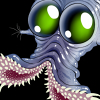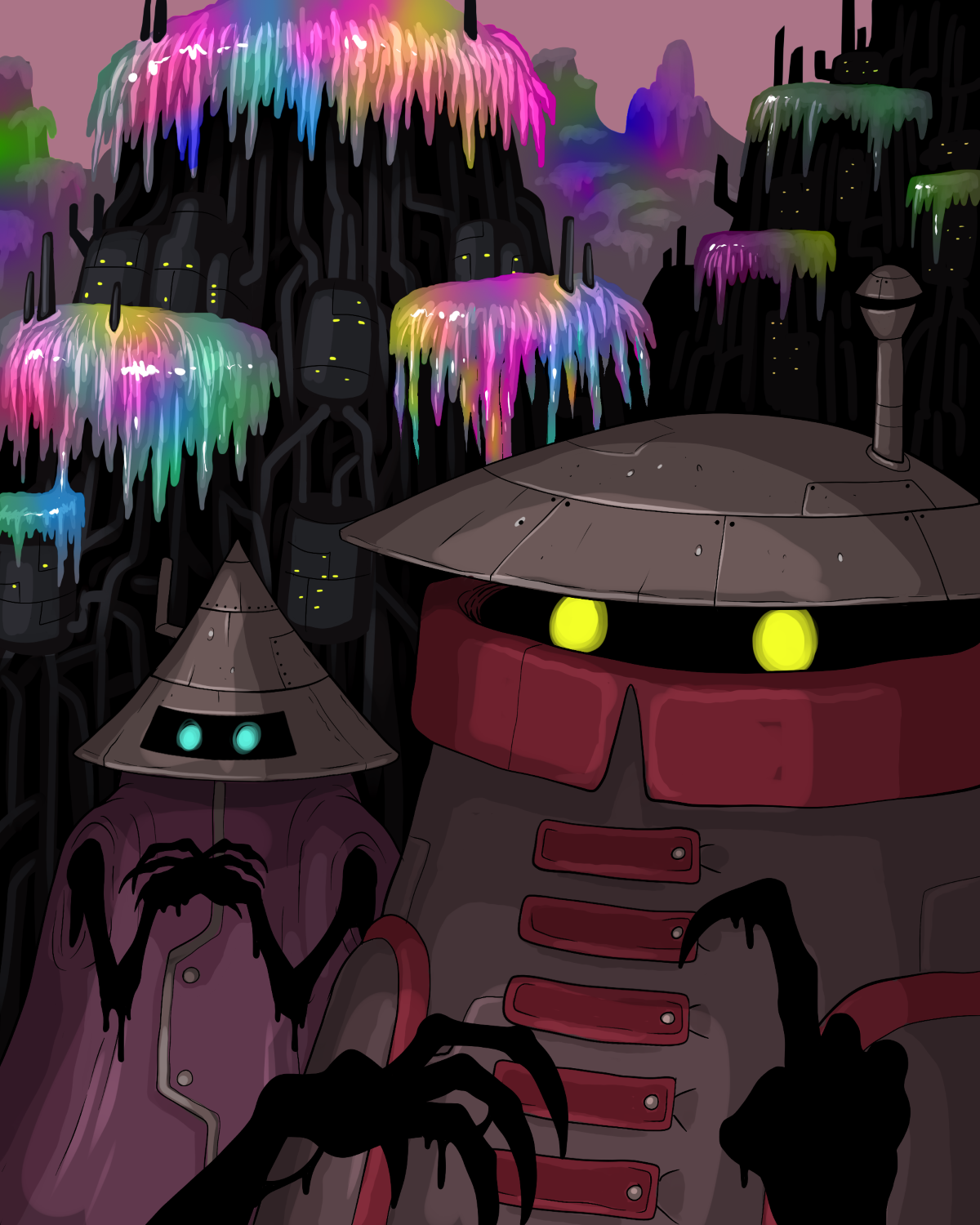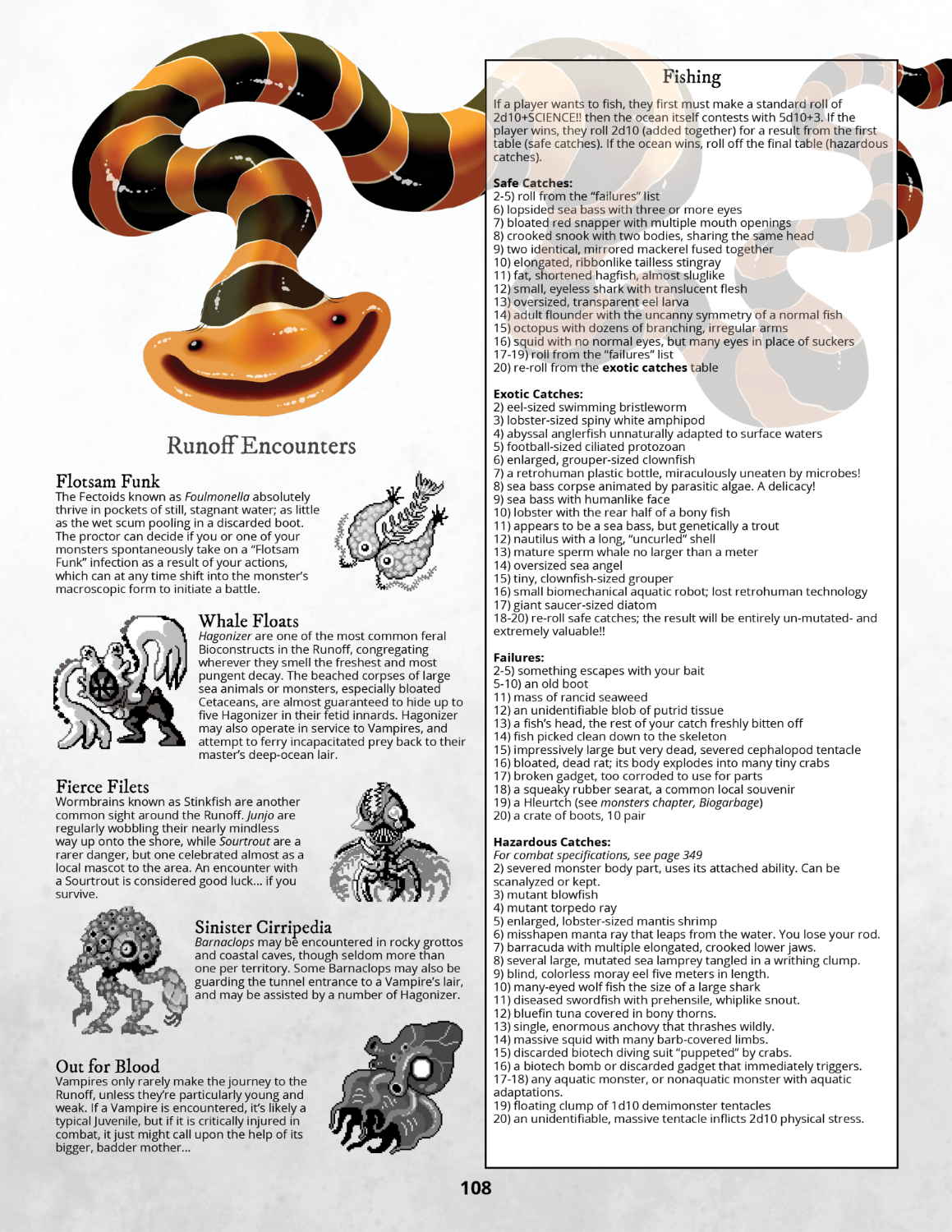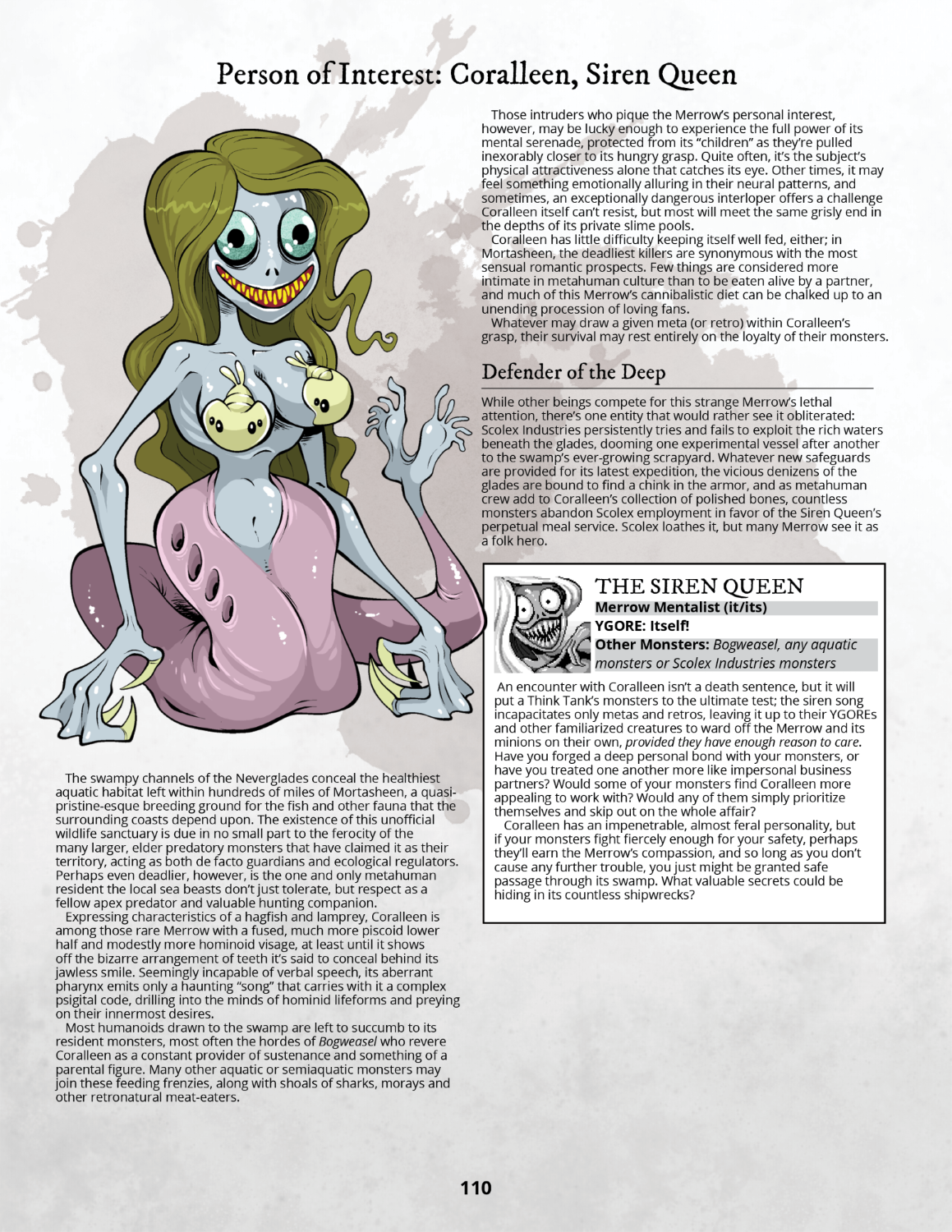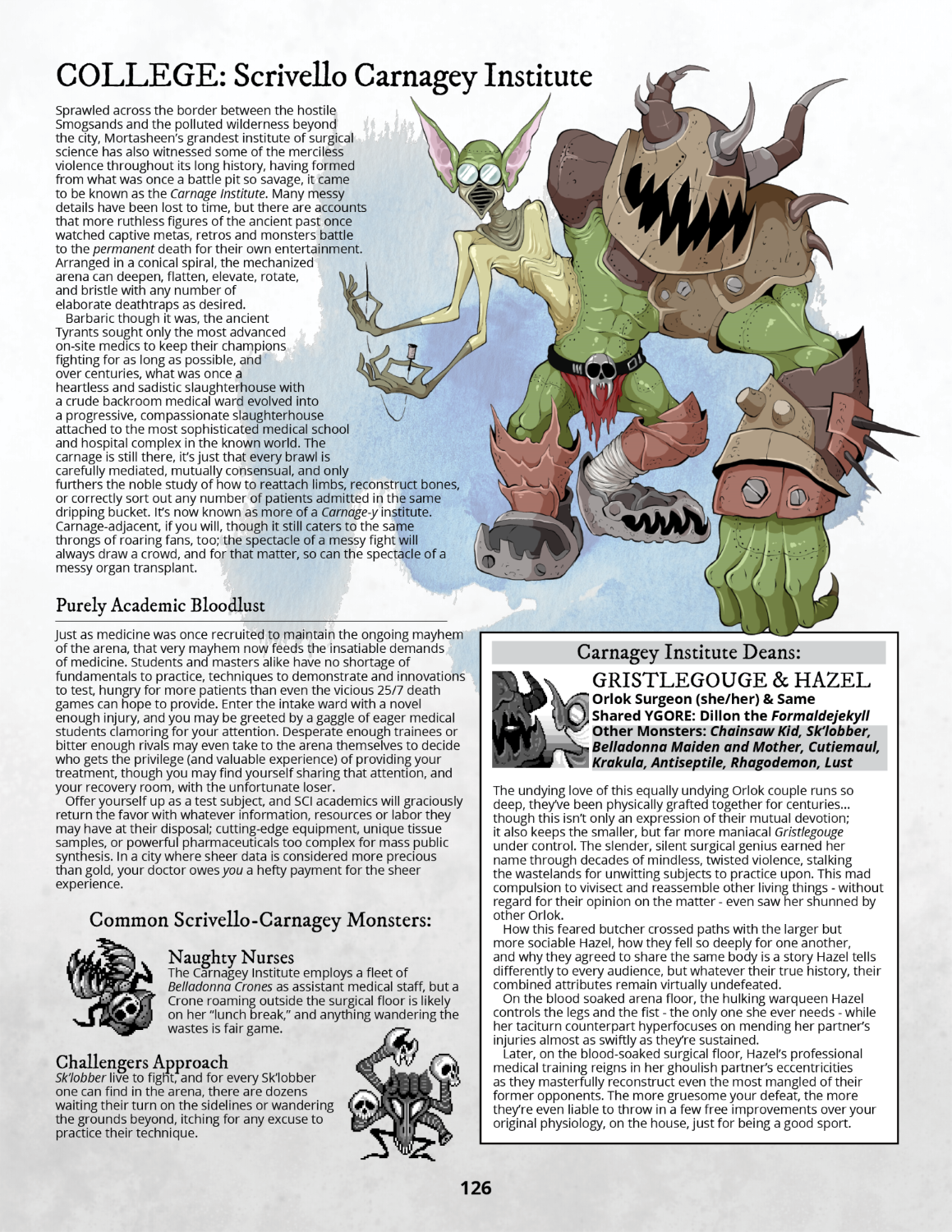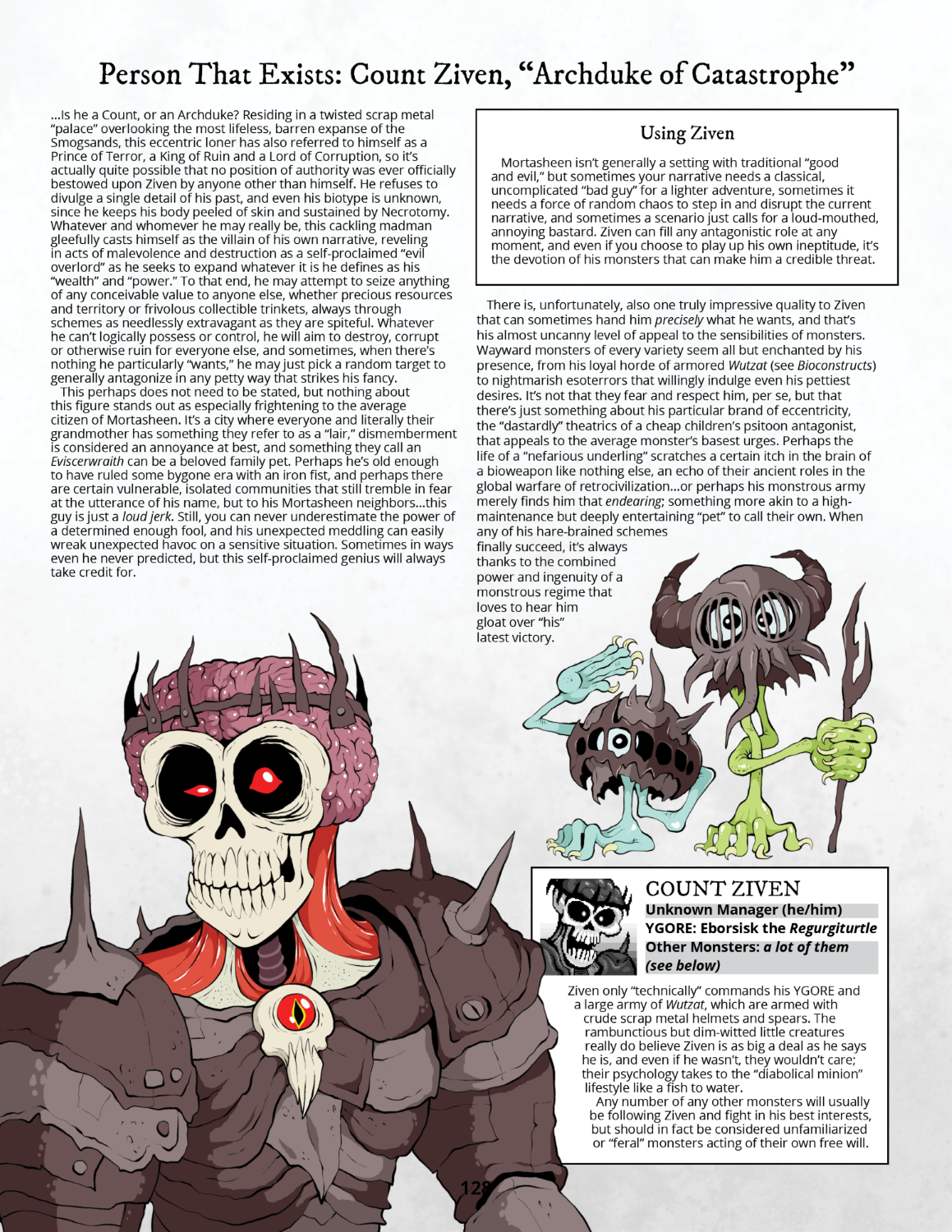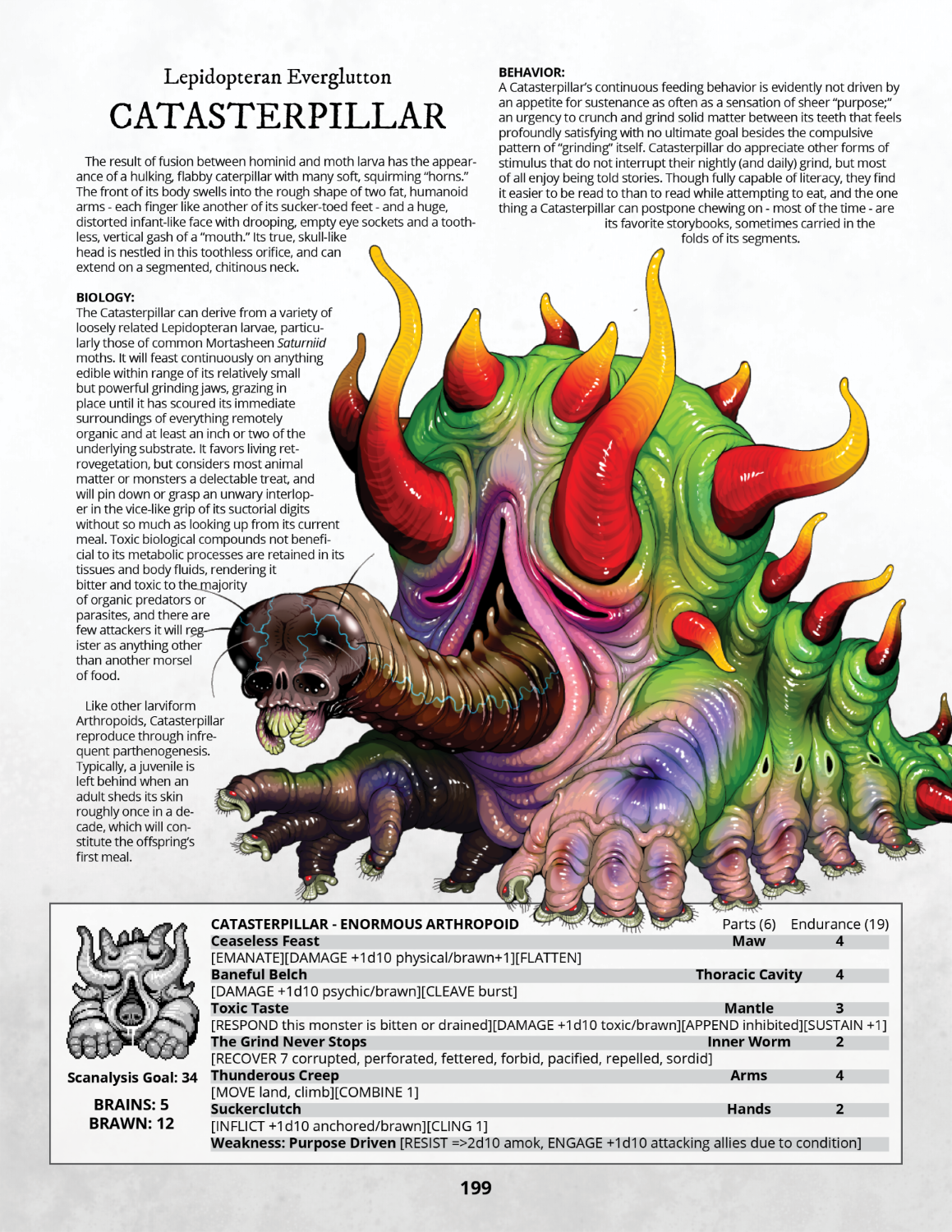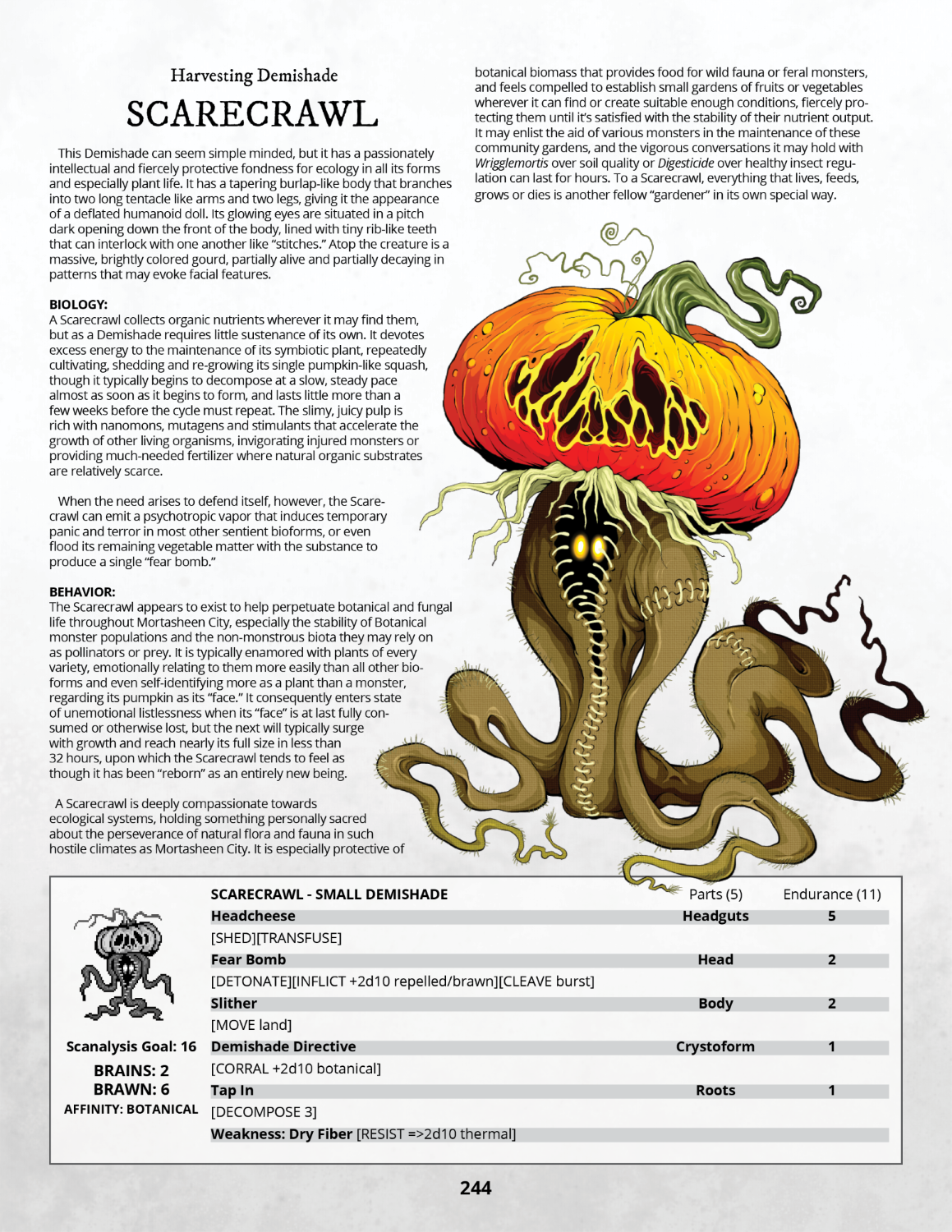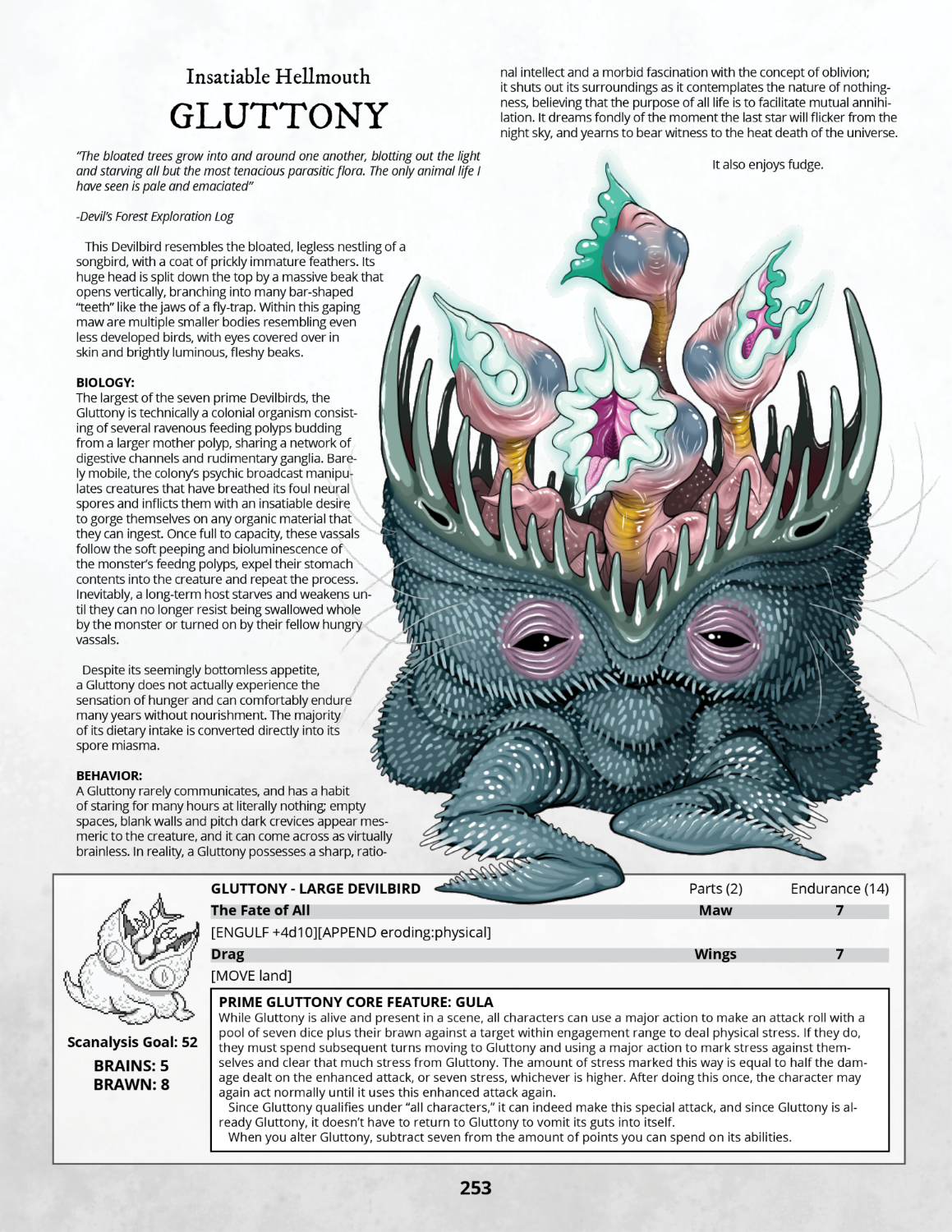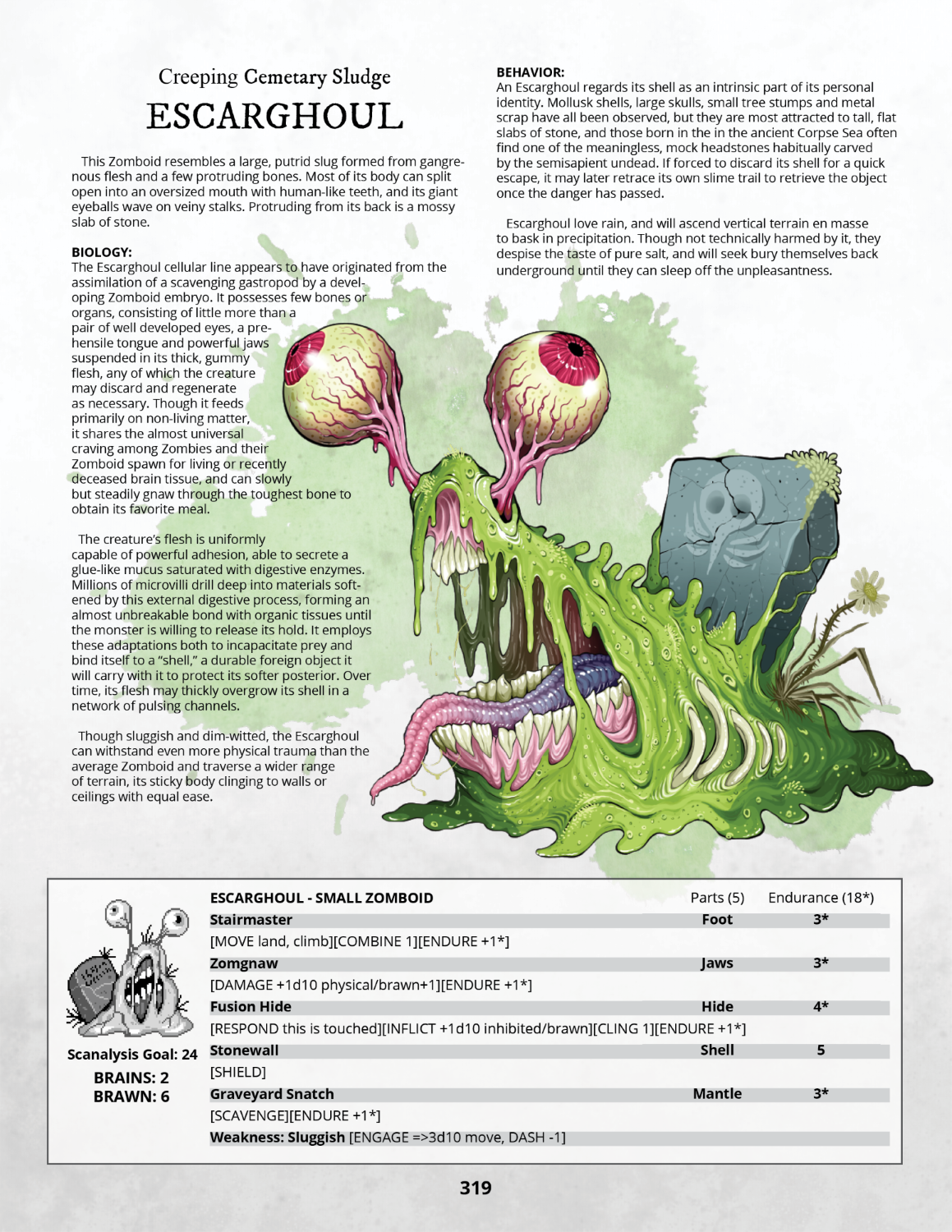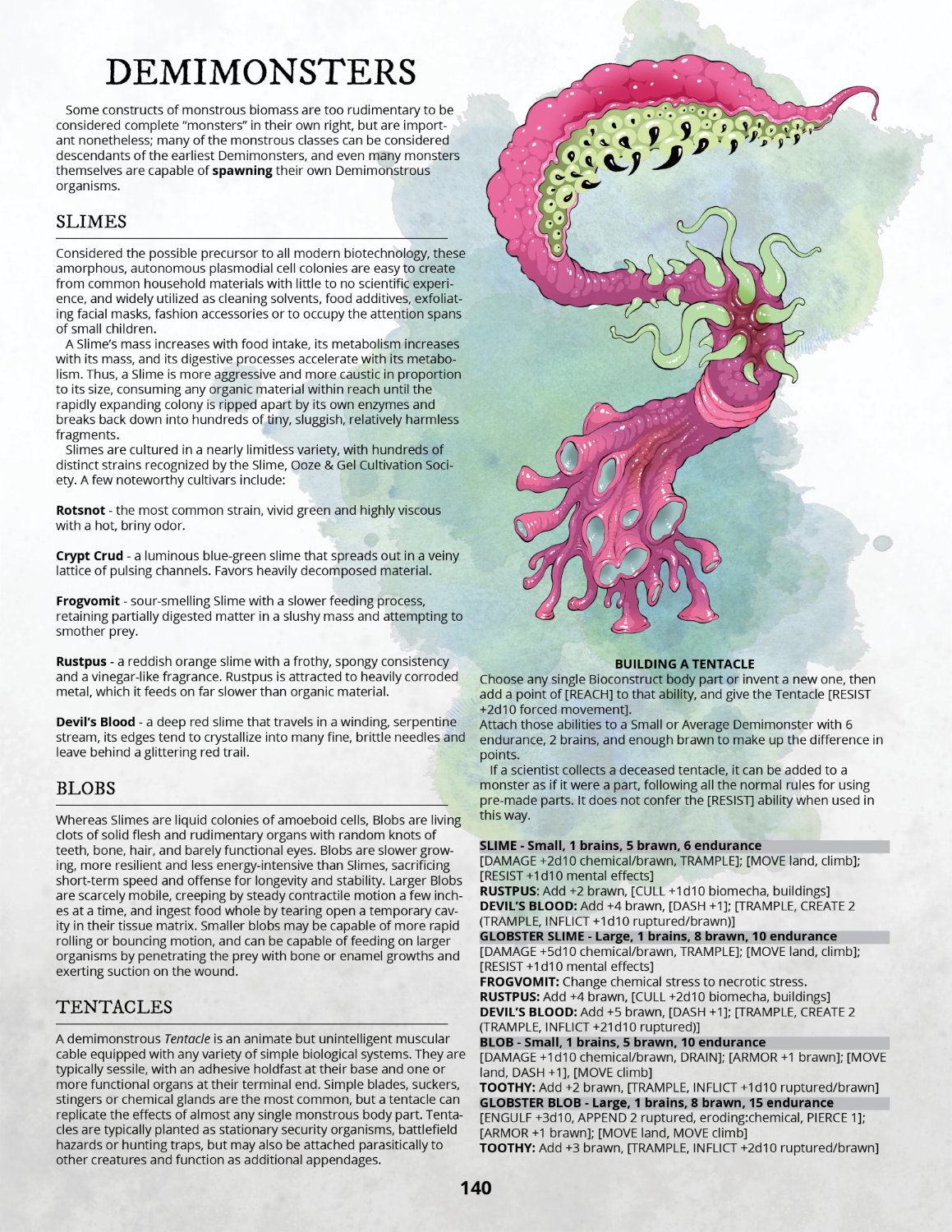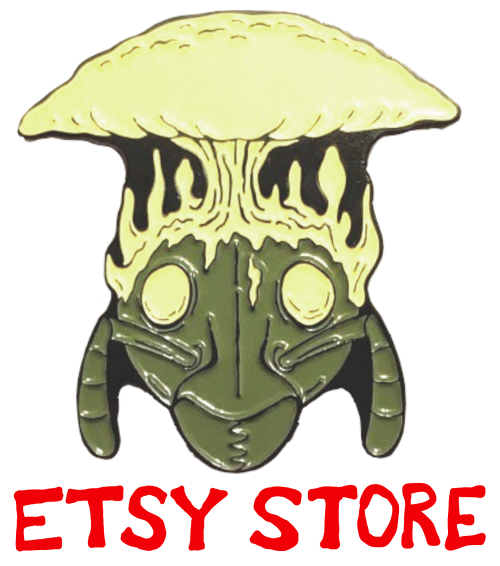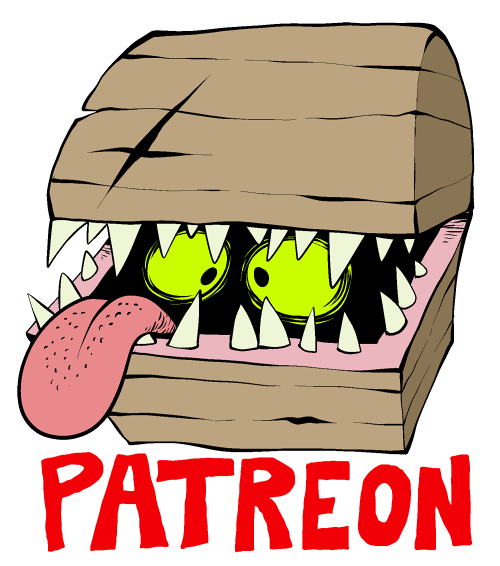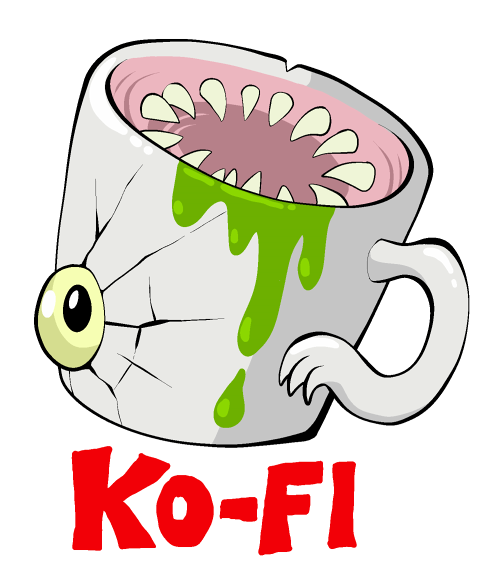PART TWO: What IS Mortasheen?
(As a Setting)
Written by Jonathan Wojcik
Before we get into 31 straight days of bonus content and the book's first experimental release, it's finally time to summarize more of the world itself and elements that you can't necessarily just glean from the old monster archive. Be sure to read the previous page if you want to know the history of Mortasheen as a creative project and new tabletop game!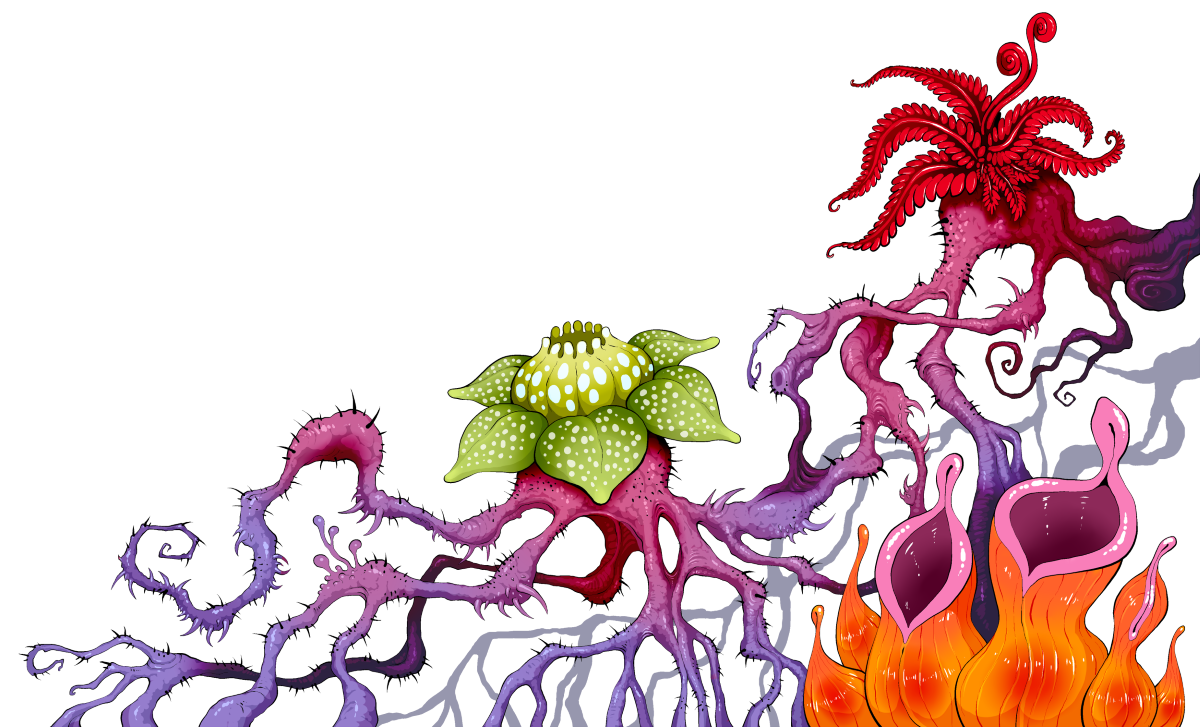
The Mortasheen World
Mortasheen takes place on a planet that may have been ours, or similar enough that it may as well have been; the kind of Earth-but-not-Earth seen in console RPG's like Pokemon, Final Fantasy or Mother (AKA Earthbound). By the time of Mortasheen's "present" however, it's already been a million (or several million) years since our own time, or whatever its equivalent was to our own time.
This is not, however, a "post apocalyptic" setting, because there wasn't any "apocalypse," but a gradual transformation as the planet scraped its way through eons of upheaval. Humanity as we know it never necessarily "collapses," but gracefully fades away from its position at the top of the pyramid as civilization experiences global warfare, dystopia, technological renaissance, utopia, technological catastrophe, natural disaster, unnatural disaster, mass extinction event, mass de-extinction event or some other unexpected pandemonium after another, and many of them more than once, until we have a world as weird and as toxic by our current standards as ours would be to a Carboniferous insect.
And what eventually rises out of all those many layers of ashes is known as...
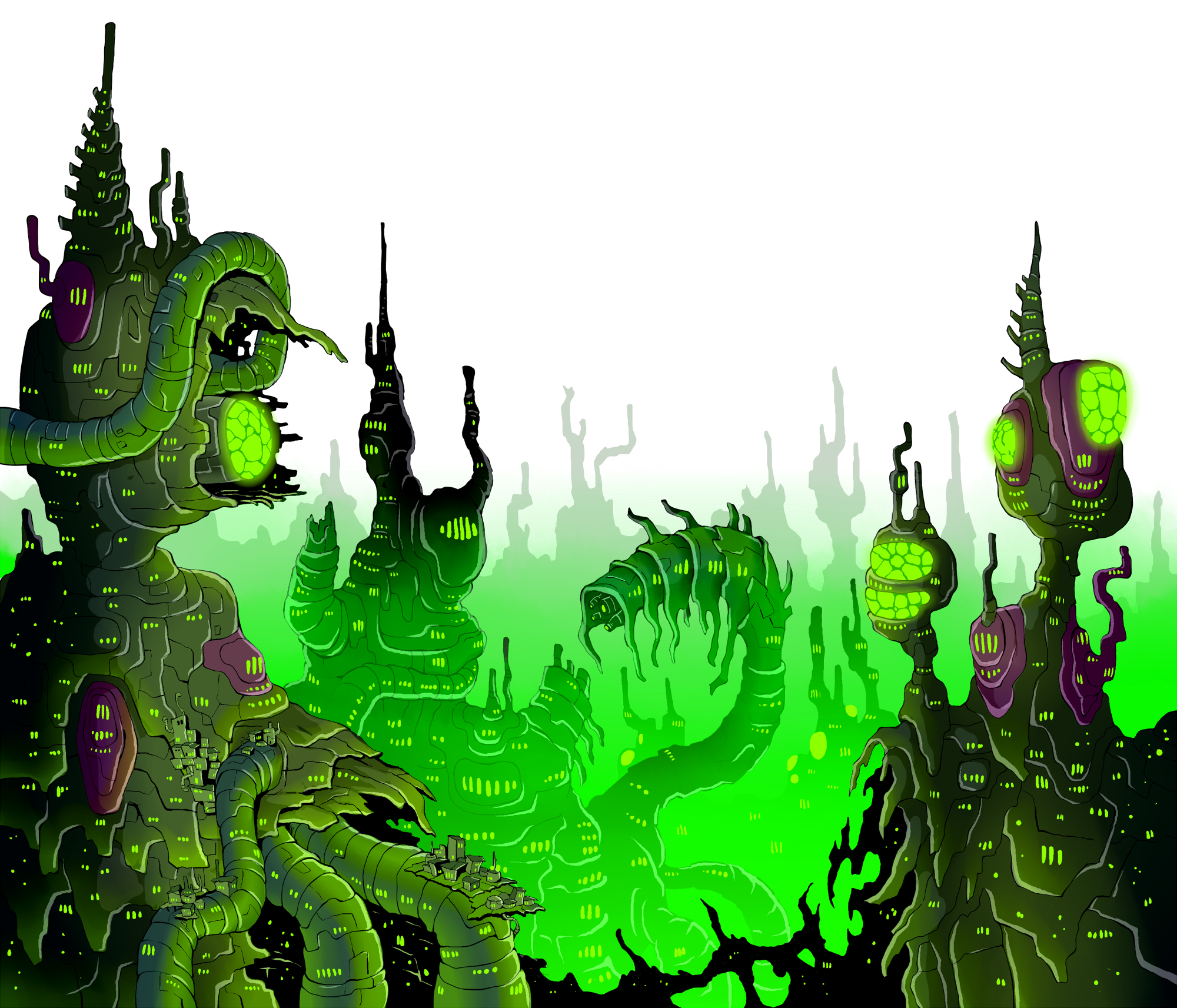
Mortasheen City
Occupying almost 40% of this planet's major supercontinent is "Mortasheen" itself, not so much an actual "city" as it is a pseudo-sentient colony of rogue biotechnology that has been steadily growing and evolving for at least a couple hundred thousand years - the overgrown child of innumerable technological achievements we left abandoned, forgotten, or deliberately buried in a world that had long ago become an unstable stew of weird pollutants we can't even imagine.
Mortasheen is massive enough that its average structure can conceivably harbor an entire biome and culture distinct from any one of its neighbors, though the majority of the city is an uncharted, probably forever unchartable labyrinth of semi-organic machinery occupied primarily by monsters and the very few "natural" animals that have taken to it, with most of those being oddball variations on rats and corvids. No entity or entities can hope to "govern" any more than their own relatively small territory. Sunlight never touches the smoggy trenches of the lower levels, and any natural geography is buried somewhere beneath hundreds of meters of unexplored self-modifying sewer systems. Book One details several city "boroughs" with their own special ecological environments, some of which include:
The Skitterwood: a colony of constantly mutating plant life that slowly migrates around the city, following seasonal gaps in the dome of smog that perpetually obscures the sun. Fresh growth at the forest's "head" presents the only actually green foliage in all the city, while the forest's rotting "tail" is followed by a constant feeding frenzy of scavenging Arthropoids.
The Rustfen: a flooded junkyard-swamp where the city has adapted to a network of acidic springs, perpetually feeding its own architecture to the corrosive mire for the benefit of beneficial fungal extremophiles. The nature of this symbiotic relationship is unclear, but the result is a landscape of crumbling oxidized biometal and rivers of red-orange sludge supporting a jungle of titanic mushrooms, acidic bacterial formations and sky-darkening mosquito swarms.
The Ridge: growing over what was once a mountain range, the highest point in Mortasheen is where the city has adapted to expel the bulk of its most unwanted, most unusable (at least to itself) chemical waste into the upper atmosphere, maintaining a psychedelic rainbow of multicolored vapors and equally colorful ice that even Mortasheen's resilient metahumans find sickeningly poisonous; precisely why those who manage to live there enjoy a sophisticated, glamorous social image.
These and several other locales are detailed much further in the first book, each with at least two pages of lore, points of interest, environmental conditions, which monsters you can most expect to see and even signature retrofauna; "nonmonstrous" (but still not quite normal) organisms such as the ridge's ice-boring rats or the rustfen's wading corvids.
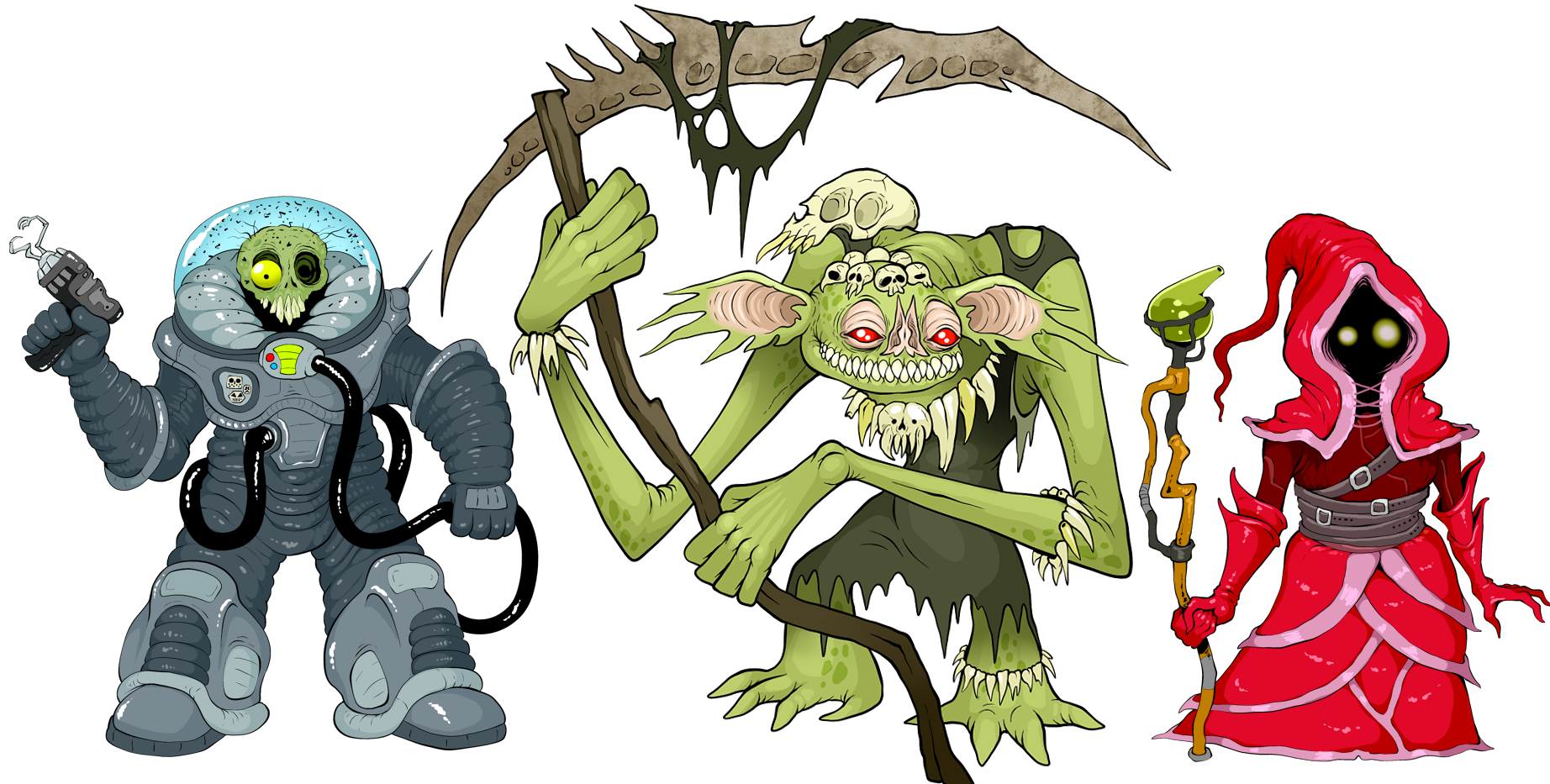
Mortasheen's People (The Player Character)
As a "monster training" setting, Mortasheen players won't play as the monsters themselves, but as the humanoids who live alongside them. To keep the two categories distinct, all player "biotypes" (ie "races") are different varieties of metahuman, descended in one way or another from our own kind; technically more fragile than almost any monster but still much, much better adapted to their world than you and I would be.
While I try to keep Mortasheen's monsters as original to the setting as possible, the metahuman biotypes intentionally cover more familiar, more generic genres of classic sci-fi horror humanoids. This gives the players something cooler and more thematic to play as than just a normal human or some sort of elf, without taking too much spotlight away from the creatures you'll be commanding. Normal humans or "retrohumans" still exist, too, but they find it considerably more challenging to survive exposure to Mortasheen's smog (or its denizens) for very long.
There are eight primary metahuman biotypes detailed in the book, with two pages and two sample characters each, though they aren't quite the only biotypes who get an appearance! The primary eight, in quicker summary, are below. (I apologize for simply repurposing the character dialog format from my webcomic, if that looks weird to anyone familiar with it!)
SHADES:
Shades are the bulk of Mortasheen's metahuman population and its only true "natives," since they're literally born from the depths of the city itself. Resembling living shadows, they're mostly silicon-based and radiation-powered, but the organic component of their nervous system links directly to us humans. The majority of Shades are created with only a single job to do, whether maintaining city systems or operating some kind of business as the city parrots what it understands of civilization. Billions of Shades happily toil at their duties like cells in a vast body, but some Shades develop more imagination or ambition than others, and some are even created to be more independent thinks from the start.
Shades were my very first concept for the "non-monster" inhabitants of the setting, and in its earliest incarnations, they were even its only non-monster inhabitants. Now they continue to occupy a role as both the go-to character archetype and the default "background character."
Shades are the bulk of Mortasheen's metahuman population and its only true "natives," since they're literally born from the depths of the city itself. Resembling living shadows, they're mostly silicon-based and radiation-powered, but the organic component of their nervous system links directly to us humans. The majority of Shades are created with only a single job to do, whether maintaining city systems or operating some kind of business as the city parrots what it understands of civilization. Billions of Shades happily toil at their duties like cells in a vast body, but some Shades develop more imagination or ambition than others, and some are even created to be more independent thinks from the start.
Shades were my very first concept for the "non-monster" inhabitants of the setting, and in its earliest incarnations, they were even its only non-monster inhabitants. Now they continue to occupy a role as both the go-to character archetype and the default "background character."
ORLOK:
these ghoulish hybrids of human, bat, reptile and various other creatures were engineered in the ancient past to serve as a sustainable, willing blood source to intelligent vampiric monsters. They live largely outside Mortasheen in mole-rat-like colonies with dozens of specialized castes, from gremlin-size tinkers to more ogre-size builders. Despite their appearance, history, and their love of sustaining battle damage (they are engineered to not mind blood loss), Orlok are actually highly intelligent, sophisticated beings that live in symbiotic harmony with their vampiric creators, and are free to leave the colony if they yearn for more adventure.
All "vampires" in Mortasheen are part of a strictly nonhumanoid monster class, so instead of making playable human-like vampires, I opted to do the opposite with a biotype that gives blood. They roll together every "goblin" or "orc" sort of creature you might miss from other game settings, but they avoid the dim-witted violence associated with such.
these ghoulish hybrids of human, bat, reptile and various other creatures were engineered in the ancient past to serve as a sustainable, willing blood source to intelligent vampiric monsters. They live largely outside Mortasheen in mole-rat-like colonies with dozens of specialized castes, from gremlin-size tinkers to more ogre-size builders. Despite their appearance, history, and their love of sustaining battle damage (they are engineered to not mind blood loss), Orlok are actually highly intelligent, sophisticated beings that live in symbiotic harmony with their vampiric creators, and are free to leave the colony if they yearn for more adventure.
All "vampires" in Mortasheen are part of a strictly nonhumanoid monster class, so instead of making playable human-like vampires, I opted to do the opposite with a biotype that gives blood. They roll together every "goblin" or "orc" sort of creature you might miss from other game settings, but they avoid the dim-witted violence associated with such.
ZOMBIES:
No one knows exactly why, but the entire known population of retrohumans (classic style humans, like us) metamorphose into a unique pseudo-lifeform shortly after brain death, and to this day there are far more "Zombies" roaming the world beyond the city than there are retros. Most of them remain near-mindless shamblers indefinitely, but a rare mutation triggered by the regular consumption of healthy brain tissue can imbue a shambler with newfound consciousness. While evidently terrifying to retros of the ancient past, shamblers are now little more than an odd nuisance, and awakened specimens or "revenants" are welcomed both by Mortasheen and retrohuman cultures. Their bodies are in a constant cycle of decay and rejuvenation, and they tend to be colonized by insects, worms or other biota they identify as almost a direct extension of themselves.
Zombie media was nowhere near as saturated back when I began this setting, but even then I wanted to subvert the hallmarks of zombie-centric settings, making "my" Zombies more of a minor background element. Even surviving humans have completely adapted to their existence.
No one knows exactly why, but the entire known population of retrohumans (classic style humans, like us) metamorphose into a unique pseudo-lifeform shortly after brain death, and to this day there are far more "Zombies" roaming the world beyond the city than there are retros. Most of them remain near-mindless shamblers indefinitely, but a rare mutation triggered by the regular consumption of healthy brain tissue can imbue a shambler with newfound consciousness. While evidently terrifying to retros of the ancient past, shamblers are now little more than an odd nuisance, and awakened specimens or "revenants" are welcomed both by Mortasheen and retrohuman cultures. Their bodies are in a constant cycle of decay and rejuvenation, and they tend to be colonized by insects, worms or other biota they identify as almost a direct extension of themselves.
Zombie media was nowhere near as saturated back when I began this setting, but even then I wanted to subvert the hallmarks of zombie-centric settings, making "my" Zombies more of a minor background element. Even surviving humans have completely adapted to their existence.
BORG:
Borg are a metahuman lineage that long ago stripped themselves down to only their brains, spinal cords and the occasional eyeball, sustained by their own symbiotic flora that metabolize radiation. Repulsed by direct contact with any other organic tissue, they're only comfortable surrounded by glass, plastic and metal in a personal tank of nourishing isotopes, and get around in a variety of biotech bodies. They have a reputation for egomania, perceiving themselves as more intelligent than other biotypes, and sometimes struggle to empathize with non-borg.
Mortasheen doesn't normally have "robots" or "computerized" intelligence, though you're perfectly free to have a fully mechanized character if the idea is significant enough to you. Otherwise, any machine-like Mortasheen denizens are understood to be powered by living or at least biotechnological brains, many of which are Borg, who are already "born" (cultivated) bodiless.
Borg are a metahuman lineage that long ago stripped themselves down to only their brains, spinal cords and the occasional eyeball, sustained by their own symbiotic flora that metabolize radiation. Repulsed by direct contact with any other organic tissue, they're only comfortable surrounded by glass, plastic and metal in a personal tank of nourishing isotopes, and get around in a variety of biotech bodies. They have a reputation for egomania, perceiving themselves as more intelligent than other biotypes, and sometimes struggle to empathize with non-borg.
Mortasheen doesn't normally have "robots" or "computerized" intelligence, though you're perfectly free to have a fully mechanized character if the idea is significant enough to you. Otherwise, any machine-like Mortasheen denizens are understood to be powered by living or at least biotechnological brains, many of which are Borg, who are already "born" (cultivated) bodiless.
MUTANTS:
The metahumans closest of all to their retrohuman ancestors. Mutants always look recognizably human, but are almost never as symmetrical, their eyeballs tend to be at least a little (or a whole lot) larger and they often have a more extreme anatomical deviation all their own. Common examples include the presence of an additional massive eyeball or eyeballs somewhere other than their head, one or more highly elongated limbs or masses of overgrown flesh. Whatever their appearance, mutants are incredibly durable and long lived with a strong appetite for noxious chemicals and synthetic materials, even snacking on (and successfully digesting) plastic of any kind.
"Mutants" like these are all over pop culture, especially in post-apocalyptic settings, and were the obvious choice for Mortasheen's "most human" everyman archetype.
The metahumans closest of all to their retrohuman ancestors. Mutants always look recognizably human, but are almost never as symmetrical, their eyeballs tend to be at least a little (or a whole lot) larger and they often have a more extreme anatomical deviation all their own. Common examples include the presence of an additional massive eyeball or eyeballs somewhere other than their head, one or more highly elongated limbs or masses of overgrown flesh. Whatever their appearance, mutants are incredibly durable and long lived with a strong appetite for noxious chemicals and synthetic materials, even snacking on (and successfully digesting) plastic of any kind.
"Mutants" like these are all over pop culture, especially in post-apocalyptic settings, and were the obvious choice for Mortasheen's "most human" everyman archetype.
MERROW:
Amphibious metahumans hybridized with a wide variety of water-breathing chordates ("fish") whose characteristics are expressed in random combinations from one individual to the next. Some are just exceptionally bug-eyed, slimy-skinned hominids, while others may have piscoid faces, fins, scales or even fused tail-like legs. They were created by Vampires long before the perfection of the Orlok, but lived more as cattle and slaves than as symbiotes. While that's generally just ancient history by now, Merrow still tend to be more cautious and practical about their world than other metas, though they also have a rich culture of mythology and storytelling, as if some part of their retrohuman subconscious is well aware that they've become something straight out of ancient folklore.
You just can't go wrong with fish people is all.
Amphibious metahumans hybridized with a wide variety of water-breathing chordates ("fish") whose characteristics are expressed in random combinations from one individual to the next. Some are just exceptionally bug-eyed, slimy-skinned hominids, while others may have piscoid faces, fins, scales or even fused tail-like legs. They were created by Vampires long before the perfection of the Orlok, but lived more as cattle and slaves than as symbiotes. While that's generally just ancient history by now, Merrow still tend to be more cautious and practical about their world than other metas, though they also have a rich culture of mythology and storytelling, as if some part of their retrohuman subconscious is well aware that they've become something straight out of ancient folklore.
You just can't go wrong with fish people is all.
SECTILIANS:
These metas are born looking human , save for their pure white eyes and colorless grey skin, and are significantly more vulnerable than most other metas. But at a certain point in their lives, every Sectilian becomes obsessed with a singular variety of arthropod, and will outright die if they don't step into the family Sectopod - a living chrysalis-like biotech chamber - with a living sample of their "dreambug." What emerges from the pod are two creatures, the humanoid and the arthropod, with a single united mind and a portion of their body plan "swapped;" often at least some of the head and up to half of their limbs, though almost any combination is possible. This is only really surface aesthetic - there's still human flesh and bone beneath that giant housefly or mantis head - but the successfully matured Sectilian is as resilient as any Mutant. They have a culture of what can best be described as "bioscience cults," organized into clans with their own signature hyperfixations such as the study of pollination, metamorphosis, venom, parasitism, evolutionary theory and more.
An entire "player race" based on The Fly was just obligatory, both for me personally and a setting themed around Mad Science. Canonically, they never have more than a head and arm's worth of "bug" to them however, since a "full" bug-person hybrid is already one of our monster classes, which we're getting into next!
These metas are born looking human , save for their pure white eyes and colorless grey skin, and are significantly more vulnerable than most other metas. But at a certain point in their lives, every Sectilian becomes obsessed with a singular variety of arthropod, and will outright die if they don't step into the family Sectopod - a living chrysalis-like biotech chamber - with a living sample of their "dreambug." What emerges from the pod are two creatures, the humanoid and the arthropod, with a single united mind and a portion of their body plan "swapped;" often at least some of the head and up to half of their limbs, though almost any combination is possible. This is only really surface aesthetic - there's still human flesh and bone beneath that giant housefly or mantis head - but the successfully matured Sectilian is as resilient as any Mutant. They have a culture of what can best be described as "bioscience cults," organized into clans with their own signature hyperfixations such as the study of pollination, metamorphosis, venom, parasitism, evolutionary theory and more.
An entire "player race" based on The Fly was just obligatory, both for me personally and a setting themed around Mad Science. Canonically, they never have more than a head and arm's worth of "bug" to them however, since a "full" bug-person hybrid is already one of our monster classes, which we're getting into next!
MUSHMEN:
Its skeleton is human, and its organs semi-human, but the rest of a Mushman is a colony of fungus, algae, bacteria and protozoa, resembling a humanoid mass of fungus or pond scum sometimes colonized in turn by plant life or tiny fauna. They get along swimmingly well with Zombies, and there are theories that the two are in some way related. Most Mushmen work hard to maintain their personal biome, their particular composition of symbiotes as important to their self-identity as hair, clothes and gender might be to a retrohuman, and are thus unavoidably attuned to basic principles of ecology, microbiology, pharmacology and even gastronomy - it's hard not to pick up on some of the biochemical properties of your own "flesh." They therefore have a reputation for medical knowledge, cooking skill and a masterful talent for gardening.
I once held that some Zombies simply overgrew with epiphytic flora, and could end up looking like "swamp monsters" or "mushroom people." This was slightly too interesting to leave as only a subcategory of Zombie for very long, and maybe I'll even come to split Mushmen up further, making the swamp-muck variation into its own Meta?
Its skeleton is human, and its organs semi-human, but the rest of a Mushman is a colony of fungus, algae, bacteria and protozoa, resembling a humanoid mass of fungus or pond scum sometimes colonized in turn by plant life or tiny fauna. They get along swimmingly well with Zombies, and there are theories that the two are in some way related. Most Mushmen work hard to maintain their personal biome, their particular composition of symbiotes as important to their self-identity as hair, clothes and gender might be to a retrohuman, and are thus unavoidably attuned to basic principles of ecology, microbiology, pharmacology and even gastronomy - it's hard not to pick up on some of the biochemical properties of your own "flesh." They therefore have a reputation for medical knowledge, cooking skill and a masterful talent for gardening.
I once held that some Zombies simply overgrew with epiphytic flora, and could end up looking like "swamp monsters" or "mushroom people." This was slightly too interesting to leave as only a subcategory of Zombie for very long, and maybe I'll even come to split Mushmen up further, making the swamp-muck variation into its own Meta?
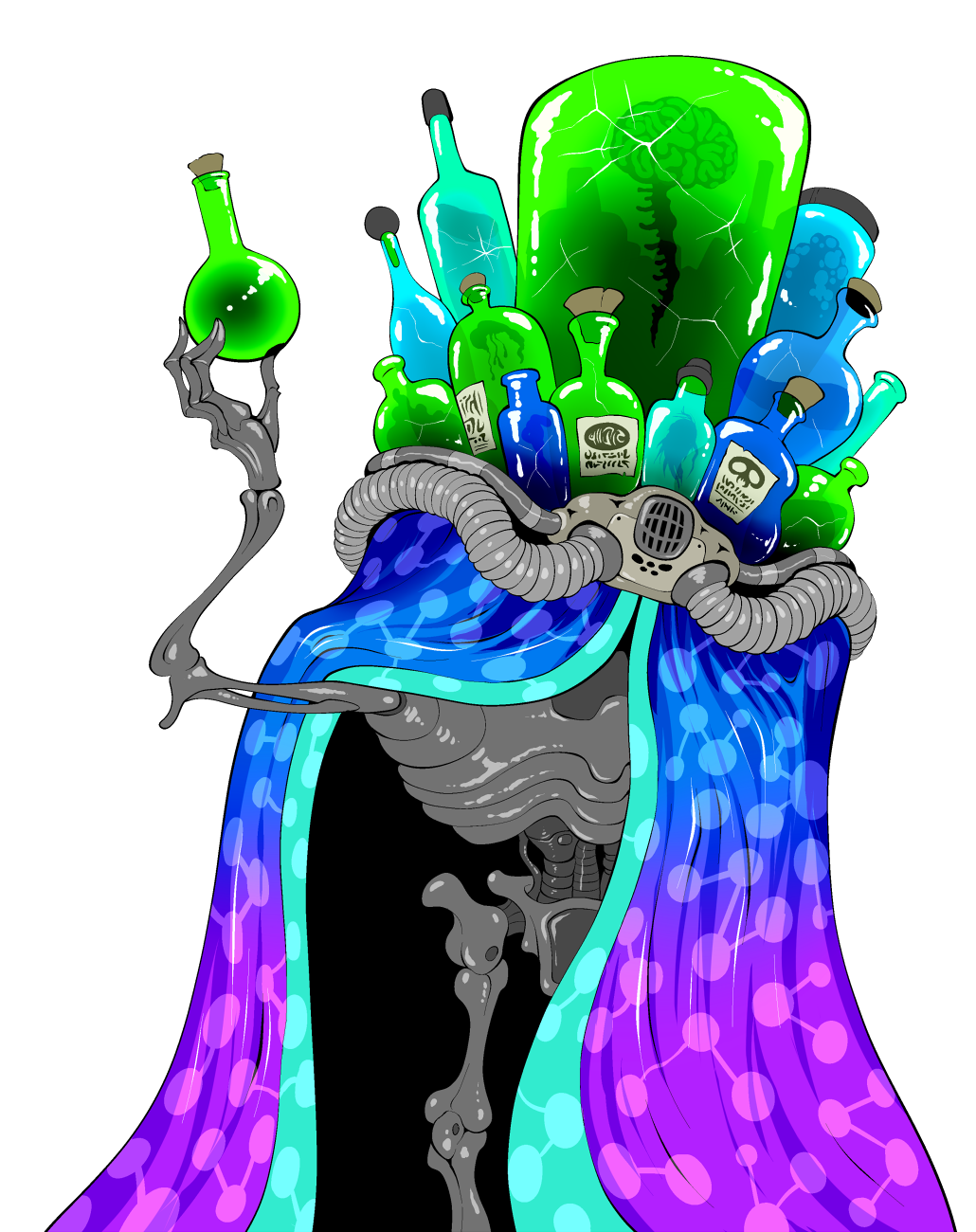
SCIENTIFIC DISCIPLINES:
Mortasheen has no centralized government or leadership, but as a science and tech based society, its oldest, largest laboratories control large territories and require enough staff that they operate precisely like the college institutions of our own world. A scientific discipline is what you'll choose for your character instead of the "job" or "class" of other gaming worlds, each with a long list of unique perks to unlock in book one. Examples of some of the disciplines include:
GENETICS: the go-to choice for the study of living or semiliving beings, Geneticists excel at monster creation and modification. Their institute is a labyrinth of both living and preserved specimen containers packed so densely, even light fixtures and toilet tanks have been modified to house someone or other's study subject. Dangerous containment breaches are so constant, the alarms were long ago modified into more pleasant, unobtrusive musical code.
ALCHEMISTRY: chemistry is a part of every discipline in some way, but alchemistry is the advanced art of controlling chemical processes and reactions at the microscopic level through subconscious communication with nanomons. "Alchemists" chose the more fanciful name for themselves and romanticize the periodic table as a veritable magic spellbook (...but isn't it?) Their college is formed almost entirely of tangled pipeworks and colorful crystalline tanks, coursing with so many volatile substances that the city produced a dedicated line of shades expressly to map out the facility and keep tabs on its every microliter. Accidents still happen, a lot, and the unwary only add to an ever-growing archive of highly educational jarred remains.
MANAGEMENT: sometimes, nothing is more powerful in the face of total chaos than someone sick enough to love paperwork. Eccentric and even a bit unnerving by Mortasheen's standards, Managers are masters of planning and organization who live to implement systems of order and procedure. They're record keepers, negotiators and regulators in a world where the closest thing some entities have to a "government" is an unusually domineering fungal infection. Their sterile, colorless, all-too-euclidian base of operations is like an ever-shifting puzzle of countless modular cubes where outsiders dare not tread, lest they incorrectly stamp the necessary documents to retain ownership of their vertebrae in subquadrant configuration 483:001:07, or foolishly overlook the clearly posted reminder that Cube 2837I-B1 (bathrooms) is scheduled at 101:434:0006 in the evening to intersect with Cube 28371-BI (incinerator).
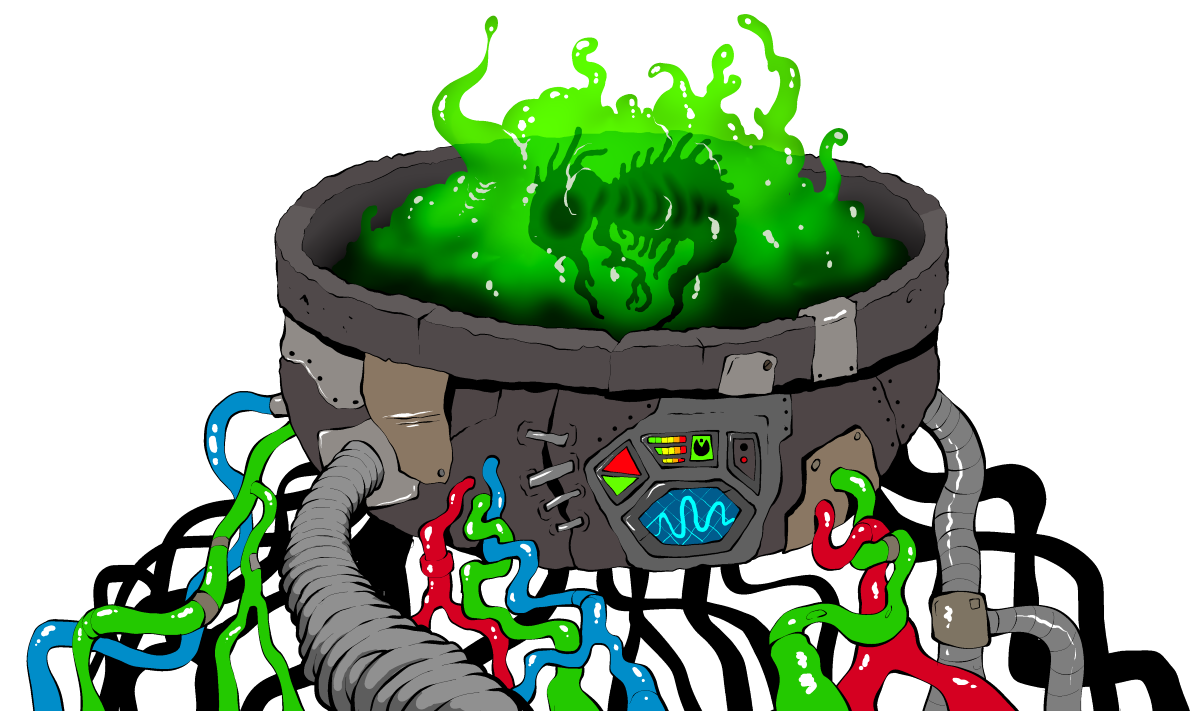
THE MONSTERS
"Monsters" in the Mortasheen world are a nebulous concept, but generally defined as metanatural lifeforms distinct from either transcended humans or mutated wildlife. All monsters are of slightly alien mentality, but still usually sapient enough for our kind to communicate with on some level. All can be categorized under one of several possible classes, and all can be created, replicated or altered in some way via the Green Goo - the living sentient "blood" of Mortasheen city itself.
The current monster classes in book one vary a little from those in the original monster archive. The following is their complete list, and if you were wondering, every monster in Book One does also come with a faux-gameboy-style pixel sprite:
BIOCONSTRUCTS
The most common monster class. Bioconstructs are organic or largely organic monsters intelligently engineered by other beings for specialized purposes, but most commonly represent living weaponry from across the many eras that lead up to Mortasheen's current world. New varieties are constantly engineered by the city's metahuman populace, and the most successful tend to establish themselves as a permanent part of the city's ecosystem. They feel kinship with the city biotech and the Green Goo, which is still pumped through their bodies by a teratomorphic core.
Bioconstructs are the easiest monsters to customize, and the first monsters players will typically learn to create themselves.
The most common monster class. Bioconstructs are organic or largely organic monsters intelligently engineered by other beings for specialized purposes, but most commonly represent living weaponry from across the many eras that lead up to Mortasheen's current world. New varieties are constantly engineered by the city's metahuman populace, and the most successful tend to establish themselves as a permanent part of the city's ecosystem. They feel kinship with the city biotech and the Green Goo, which is still pumped through their bodies by a teratomorphic core.
Bioconstructs are the easiest monsters to customize, and the first monsters players will typically learn to create themselves.
DEMISHADES
While pure shades are the city's attempt to create its own people, Demishades are the city's effort in creating its own monsters, with more biological material and more specialized purposes than their metahuman counterparts. Every Demishade mirrors some other class of monster, which it tends to get along with best. Demishades are also more active in seeking partnership with metahumans or feral monsters than many other classes, driven by the city's subconscious desire to comprehend its own denizens.
Demishades were originally conceived as a subcategory of Bioconstruct, but spun off into their own class for the game, and serve as universal "starter" monsters.
While pure shades are the city's attempt to create its own people, Demishades are the city's effort in creating its own monsters, with more biological material and more specialized purposes than their metahuman counterparts. Every Demishade mirrors some other class of monster, which it tends to get along with best. Demishades are also more active in seeking partnership with metahumans or feral monsters than many other classes, driven by the city's subconscious desire to comprehend its own denizens.
Demishades were originally conceived as a subcategory of Bioconstruct, but spun off into their own class for the game, and serve as universal "starter" monsters.
ARTHROPOIDS
Created by the same ancient biotechnology as Sectilian metahumans, but more seamlessly hybridized; an Arthropoid species begins as a fusion of an arthropod with either a Sectilian or retrohuman, losing enough of its humanity in the process to qualify as a true Monster. Once created, an Arthropoid can multiply with almost any other Arthropoid to produce offspring of the mother's species, and billions of them continue thriving in the depths of the city and beyond.
Creation of an entirely new Arthropoid species is uncommon and challenging, but they make common "wild" monsters players can befriend.
Created by the same ancient biotechnology as Sectilian metahumans, but more seamlessly hybridized; an Arthropoid species begins as a fusion of an arthropod with either a Sectilian or retrohuman, losing enough of its humanity in the process to qualify as a true Monster. Once created, an Arthropoid can multiply with almost any other Arthropoid to produce offspring of the mother's species, and billions of them continue thriving in the depths of the city and beyond.
Creation of an entirely new Arthropoid species is uncommon and challenging, but they make common "wild" monsters players can befriend.
BOTANICALS
Similar in most ways to Bioconstructs, but with plant-animal hybrid tissues comprising anywhere from 25%-80% of their biomass, most Botanicals are actually descended by selective breeding, modification or random mutation from abnormal plant tissues that grow parasitically on Mortasheen's green goo channels, borrowing characteristics from other monster classes or mutant fauna imprinted in the goo's genetic memory.
Botanicals tend to focus on beneficial symbiosis with other creatures, with many of them focusing on support moves or self-sacrificing "edibility."
Similar in most ways to Bioconstructs, but with plant-animal hybrid tissues comprising anywhere from 25%-80% of their biomass, most Botanicals are actually descended by selective breeding, modification or random mutation from abnormal plant tissues that grow parasitically on Mortasheen's green goo channels, borrowing characteristics from other monster classes or mutant fauna imprinted in the goo's genetic memory.
Botanicals tend to focus on beneficial symbiosis with other creatures, with many of them focusing on support moves or self-sacrificing "edibility."
BIOMECHA
Considered archaic precursors to Bioconstructs, Biomecha are closer in composition to the city's own half-organic machinery, their flesh and viscera seamlessly enmeshed with biometal exoskeletons and silicon-based living circuitry. Biomecha are most of all distinguished by their interchangeable brains, possessing only limited intelligence without a donor brain or even a "pilot" to integrate with.
Brains can be harvested and preserved in-game for a range of purposes, but Biomecha are the one class designed around this mechanic, gaining different characteristics from different types of brain.
Considered archaic precursors to Bioconstructs, Biomecha are closer in composition to the city's own half-organic machinery, their flesh and viscera seamlessly enmeshed with biometal exoskeletons and silicon-based living circuitry. Biomecha are most of all distinguished by their interchangeable brains, possessing only limited intelligence without a donor brain or even a "pilot" to integrate with.
Brains can be harvested and preserved in-game for a range of purposes, but Biomecha are the one class designed around this mechanic, gaining different characteristics from different types of brain.
JOKERS
Mysterious creatures of uncertain but indisputably unnatural origin. A Joker's consciousness is housed in a toxic gas (or sometimes liquid) that courses through its rubbery body, operating under an ever-changing and incomprehensible perception of reality all its own. Jokers may act independently or come together into living "hives" with only the loosest degree of "organization."
In-game, Jokers can add unpredictable chaos by manipulating die rolls, and are considered more advanced monsters for higher level characters.
Mysterious creatures of uncertain but indisputably unnatural origin. A Joker's consciousness is housed in a toxic gas (or sometimes liquid) that courses through its rubbery body, operating under an ever-changing and incomprehensible perception of reality all its own. Jokers may act independently or come together into living "hives" with only the loosest degree of "organization."
In-game, Jokers can add unpredictable chaos by manipulating die rolls, and are considered more advanced monsters for higher level characters.
WORMBRAINS
Multiple monsters in one, a Wormbrain is a specialized host body engineered by the collectively sentient, microscopic flatworms literally serving as their brain cells, which can even spread to other creatures and temporarily hijack their bodies. Wormbrains also typically incorporate many other parasites, from nematodes to even crustaceans, enlarged and modified to function as appendages and weapons. Deep inside this fearsome amalgamation, the microscopic fluke colony lives out a more peaceful and contemplative existence, and may even vary in "culture" from one Wormbrain to the next.
Wormbrains might actually be my own personal favorite class, but it's a tough call. They're also kind of challenging to write about, given that they consist of so many distinct organisms at once, but you can consider "one" Wormbrain to be everything in its accompanying illustration as a single collective, with one body being the "host" vehicle and others being symbiotes.
Multiple monsters in one, a Wormbrain is a specialized host body engineered by the collectively sentient, microscopic flatworms literally serving as their brain cells, which can even spread to other creatures and temporarily hijack their bodies. Wormbrains also typically incorporate many other parasites, from nematodes to even crustaceans, enlarged and modified to function as appendages and weapons. Deep inside this fearsome amalgamation, the microscopic fluke colony lives out a more peaceful and contemplative existence, and may even vary in "culture" from one Wormbrain to the next.
Wormbrains might actually be my own personal favorite class, but it's a tough call. They're also kind of challenging to write about, given that they consist of so many distinct organisms at once, but you can consider "one" Wormbrain to be everything in its accompanying illustration as a single collective, with one body being the "host" vehicle and others being symbiotes.
ECTOPHASMS
Strange bioweaponry whose creators are long forgotten, Ectophasms can loosen their gelatinous tissues at the molecular level to become lighter than air or ooze through solid matter, and just easily, condense themselves into a fossil-like cryptobiotic state able to endure almost any environment for any length of time.
Ectophasms are our "ghost type," with a visual motif of prehistoric organisms. They were originally known as Ectosaurs, but I felt the new name was better suited to a monster class that doesn't always have to have a reptilian element.
Strange bioweaponry whose creators are long forgotten, Ectophasms can loosen their gelatinous tissues at the molecular level to become lighter than air or ooze through solid matter, and just easily, condense themselves into a fossil-like cryptobiotic state able to endure almost any environment for any length of time.
Ectophasms are our "ghost type," with a visual motif of prehistoric organisms. They were originally known as Ectosaurs, but I felt the new name was better suited to a monster class that doesn't always have to have a reptilian element.
FECTOIDS
Fectoids are both "monsters" and "pathogens," actually highly organized colonies of protozoa and bacteria enclosed in mostly fungus-based tissue structures. Fectoids have complex life cycles that shift between macroscopic bodies and intelligent microscopic biomes that can infect and manipulate other living things, spreading as a pathogenic stage before reconstituting one or more macroforms.
Fectoids are "giant germs" that can shift between functioning as a monster or functioning as a set of special status effects on another monster. During the game's development, we also moved all fungus-based monsters from the Botanical class to the Fectoid class.
Fectoids are both "monsters" and "pathogens," actually highly organized colonies of protozoa and bacteria enclosed in mostly fungus-based tissue structures. Fectoids have complex life cycles that shift between macroscopic bodies and intelligent microscopic biomes that can infect and manipulate other living things, spreading as a pathogenic stage before reconstituting one or more macroforms.
Fectoids are "giant germs" that can shift between functioning as a monster or functioning as a set of special status effects on another monster. During the game's development, we also moved all fungus-based monsters from the Botanical class to the Fectoid class.
VAMPIRES
Vampires are technically a form of engineered biotechnology, but the "engineer" in question is a prehistoric virus of impenetrably alien intelligence (and, theoretically, literal alien origin) that arose from the deep ocean, altering marine fauna into specialized monstrous vessels. They are highly intelligent, ageless, telekinetic superpredators who weaponize their own progenitor virus to manipulate their prey. The eldest Vampire-class monsters even far exceed the intelligence of any other monster or metahuman, and reigned supreme over the known world for one of the darkest eras in retrohuman history.
Mortasheen "vampires" are almost exclusively based on sea creatures and have a Cosmic Horror undercurrent. Since "adult" vampires are practically demigods, any Vampire recruited by a player character is usually a juvenile: just a few decades or centuries old, but still among the strongest higher-tier monsters in the setting.
Vampires are technically a form of engineered biotechnology, but the "engineer" in question is a prehistoric virus of impenetrably alien intelligence (and, theoretically, literal alien origin) that arose from the deep ocean, altering marine fauna into specialized monstrous vessels. They are highly intelligent, ageless, telekinetic superpredators who weaponize their own progenitor virus to manipulate their prey. The eldest Vampire-class monsters even far exceed the intelligence of any other monster or metahuman, and reigned supreme over the known world for one of the darkest eras in retrohuman history.
Mortasheen "vampires" are almost exclusively based on sea creatures and have a Cosmic Horror undercurrent. Since "adult" vampires are practically demigods, any Vampire recruited by a player character is usually a juvenile: just a few decades or centuries old, but still among the strongest higher-tier monsters in the setting.
WARPED
Mortasheen science is capable of a lot of things, but still hasn't proven whether "realities" can be "parallel" or "time" is something you can "travel." Efforts to break free from pesky quantum law consistently fail to produce the intended results, but occasionally spit out strange new monsters that defy physical logic in curiously consistent ways; they flicker in and out of tangibility, they react to things that aren't there (or aren't currently there?) and give off the same weird radioactive signature quite unlike anything that can be replicated. They don't have enough in common to have the same origin, but whatever any of them really are, they've been permanently altered by the experiments that brought them here, and even show some signs of integrating technology or biomaterial from Mortasheen city in the process.
Mortasheen previously had an "unknown" designation for monsters of extraterrestrial, extradimensional or indefinable origin, but over the course of game development, it was decided to rework many of them into a proper class with its own solid definition and signature mechanics.
Mortasheen science is capable of a lot of things, but still hasn't proven whether "realities" can be "parallel" or "time" is something you can "travel." Efforts to break free from pesky quantum law consistently fail to produce the intended results, but occasionally spit out strange new monsters that defy physical logic in curiously consistent ways; they flicker in and out of tangibility, they react to things that aren't there (or aren't currently there?) and give off the same weird radioactive signature quite unlike anything that can be replicated. They don't have enough in common to have the same origin, but whatever any of them really are, they've been permanently altered by the experiments that brought them here, and even show some signs of integrating technology or biomaterial from Mortasheen city in the process.
Mortasheen previously had an "unknown" designation for monsters of extraterrestrial, extradimensional or indefinable origin, but over the course of game development, it was decided to rework many of them into a proper class with its own solid definition and signature mechanics.
DEVILBIRDS
Older than Mortasheen city, older than any metahuman biotype, the Devilbirds are psychoreactive bioweapons left over from the very last, horrific global warfare between long-gone factions of retrohumanity. Their mind-bending spores modify the host's biology and amplify select emotions (like greed or wrath) into destructive behavior for no apparent purpose other than to sow discord, erode order and undermine peace of any kind, as if their forgotten creators were driven more by pure spite for their enemies than any sense of logic or foresight...but who on Earth would do that?
Book one includes seven core devilbirds and one brand-new Devilbird-class superweapon. Each variety features one extra-devastating built-in power completely unique to its species, but even a metahuman who successfully clones a Devilbird will normally fail to replicate this signature ability...at least under the current rules.
Older than Mortasheen city, older than any metahuman biotype, the Devilbirds are psychoreactive bioweapons left over from the very last, horrific global warfare between long-gone factions of retrohumanity. Their mind-bending spores modify the host's biology and amplify select emotions (like greed or wrath) into destructive behavior for no apparent purpose other than to sow discord, erode order and undermine peace of any kind, as if their forgotten creators were driven more by pure spite for their enemies than any sense of logic or foresight...but who on Earth would do that?
Book one includes seven core devilbirds and one brand-new Devilbird-class superweapon. Each variety features one extra-devastating built-in power completely unique to its species, but even a metahuman who successfully clones a Devilbird will normally fail to replicate this signature ability...at least under the current rules.
ZOMBOIDS
Zombies are rarely-sapient metahumans that awaken from the corpses of retrohumans, but Zomboids are monsters that develop as bizarre embryonic larvae within Zombie tissues, and can evolve into a wide variety of more advanced species whose weaponized physiology and seemingly calculated behavior implies an origin as intelligently designed weaponry...but by whom? Not so much "undead" as "super-living," a Zomboid can continue functioning on some level no matter how dismembered or pulverized.
Zomboids were formerly called "Zombie Spawn," with the new name chosen to sound a little more monstrous and stick to the one-word convention of the other classes. They can continue using their abilities long after another monster would be considered a corpse!
Zombies are rarely-sapient metahumans that awaken from the corpses of retrohumans, but Zomboids are monsters that develop as bizarre embryonic larvae within Zombie tissues, and can evolve into a wide variety of more advanced species whose weaponized physiology and seemingly calculated behavior implies an origin as intelligently designed weaponry...but by whom? Not so much "undead" as "super-living," a Zomboid can continue functioning on some level no matter how dismembered or pulverized.
Zomboids were formerly called "Zombie Spawn," with the new name chosen to sound a little more monstrous and stick to the one-word convention of the other classes. They can continue using their abilities long after another monster would be considered a corpse!
BIOGARBAGE
Biogarbage are generally weak, simple, scarcely intelligent "by-product" monsters generated randomly from intensive Green Goo activity, sometimes spun off while the Goo attempts to build or modify something else, sometimes spat out when the intended creation fails entirely. And since The Goo remembers everything it ever creates (or uncreates), the same Biogarbage tend to spawn time and again. Coupled with their tendency to multiply prolifically in places such as trash heaps or sewer lines, Biogarbage can quickly go from inconsequential oddity to troublesome infestation, though plenty of other monsters have come to rely on them as a staple food source. Many are also fairly popular as children's pets, some are considered a delicacy, and some can present any number of unexpected uses. Biogarbage are also capable of extreme mutation and growth into larger and more formidable Garbage Beasts!
Biogarbage monsters were originally conceived of as completely "useless," but Bonnie designed them to be near-serviceable low-level monsters, especially with some modifications back at your lab; they're just naturally riddled with weaknesses, too.
Biogarbage are generally weak, simple, scarcely intelligent "by-product" monsters generated randomly from intensive Green Goo activity, sometimes spun off while the Goo attempts to build or modify something else, sometimes spat out when the intended creation fails entirely. And since The Goo remembers everything it ever creates (or uncreates), the same Biogarbage tend to spawn time and again. Coupled with their tendency to multiply prolifically in places such as trash heaps or sewer lines, Biogarbage can quickly go from inconsequential oddity to troublesome infestation, though plenty of other monsters have come to rely on them as a staple food source. Many are also fairly popular as children's pets, some are considered a delicacy, and some can present any number of unexpected uses. Biogarbage are also capable of extreme mutation and growth into larger and more formidable Garbage Beasts!
Biogarbage monsters were originally conceived of as completely "useless," but Bonnie designed them to be near-serviceable low-level monsters, especially with some modifications back at your lab; they're just naturally riddled with weaknesses, too.
THE BOO MEN
These rare, powerful monsters have more "human" biological qualities than any other class, almost blurring the line between monster and meta, and each "species" is technically one unique individual spread across many identical bodies, most of them in hibernation until an active body needs replacing. Some say they were monsters that sought humanity, and others say they were humans who abandoned it, but for whatever reason, every Boo Man has the same strange compulsion to kill for hire, uncontrollably driven to exchange their combat skills for something or other of personal value.
Named after a more archaic term for "bogeyman," these were previously considered special legendary Bioconstructs, but warranted their own class and mechanics for the final rules system of Book One. Just four of them appear in the book so far; one with brand new artwork, and one that's 100% new by a guest designer!
These rare, powerful monsters have more "human" biological qualities than any other class, almost blurring the line between monster and meta, and each "species" is technically one unique individual spread across many identical bodies, most of them in hibernation until an active body needs replacing. Some say they were monsters that sought humanity, and others say they were humans who abandoned it, but for whatever reason, every Boo Man has the same strange compulsion to kill for hire, uncontrollably driven to exchange their combat skills for something or other of personal value.
Named after a more archaic term for "bogeyman," these were previously considered special legendary Bioconstructs, but warranted their own class and mechanics for the final rules system of Book One. Just four of them appear in the book so far; one with brand new artwork, and one that's 100% new by a guest designer!
Enjoy a handful of samples from our 350 finished pages. Starting tomorrow, October 2025 will present a new playable bonus monster each and every day, which will bring the game's total debut bestiary to more than 200 creatures!
NEXT: DAILY FREE OCTOBER MONSTERS BEGIN
